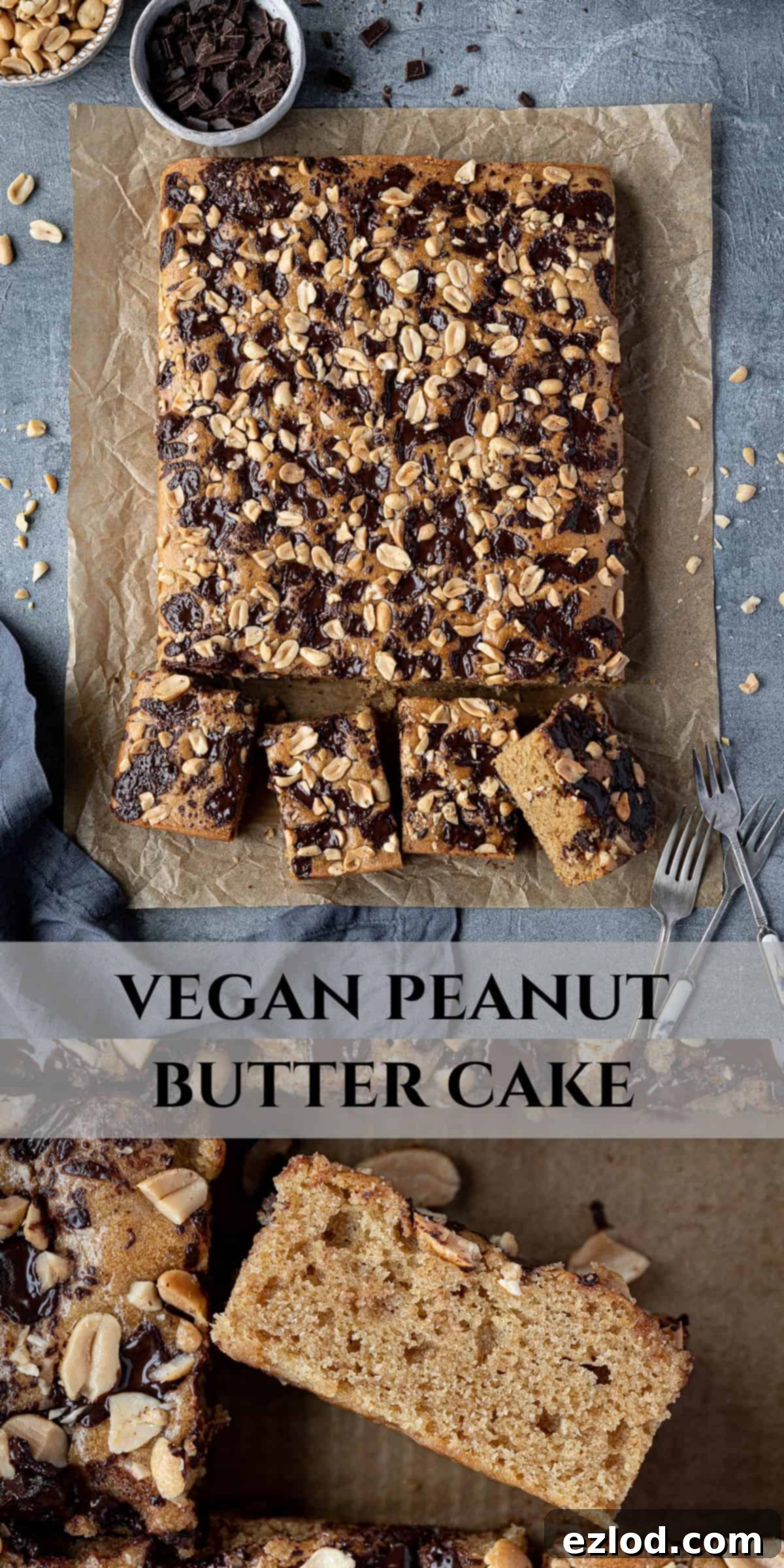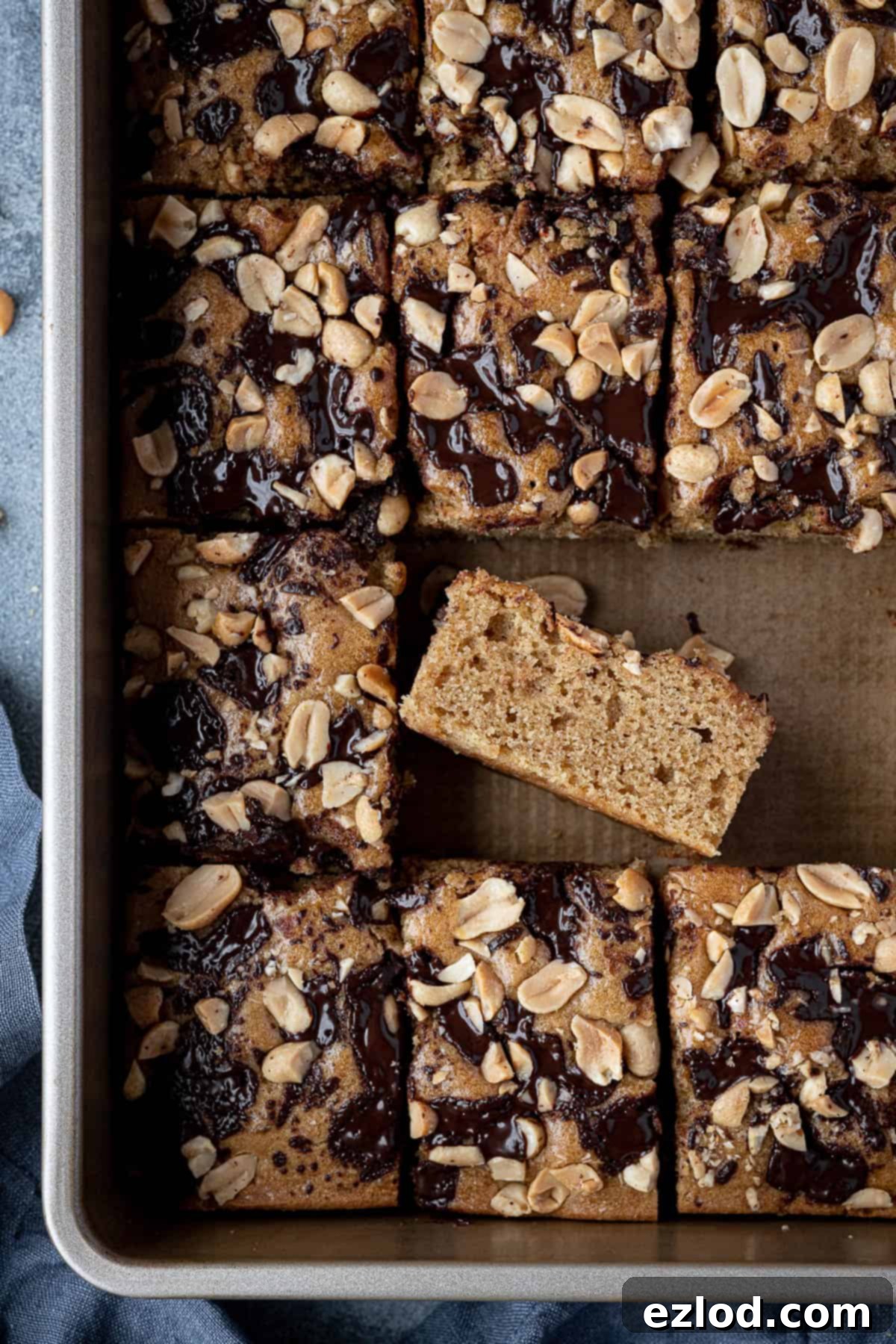The Best Vegan Peanut Butter Sheet Cake: Moist, Easy, & Topped with Chocolate and Peanuts
Indulge in the ultimate vegan treat with this incredibly delicious peanut butter sheet cake. Infused with rich peanut butter flavor, studded with decadent chocolate chips, and crowned with crunchy roasted peanuts, this cake is more than just a snack—it’s an experience. Prepare to be amazed by its moist, fluffy texture and utterly satisfying taste, proving that plant-based baking can be both effortless and extraordinarily delicious.
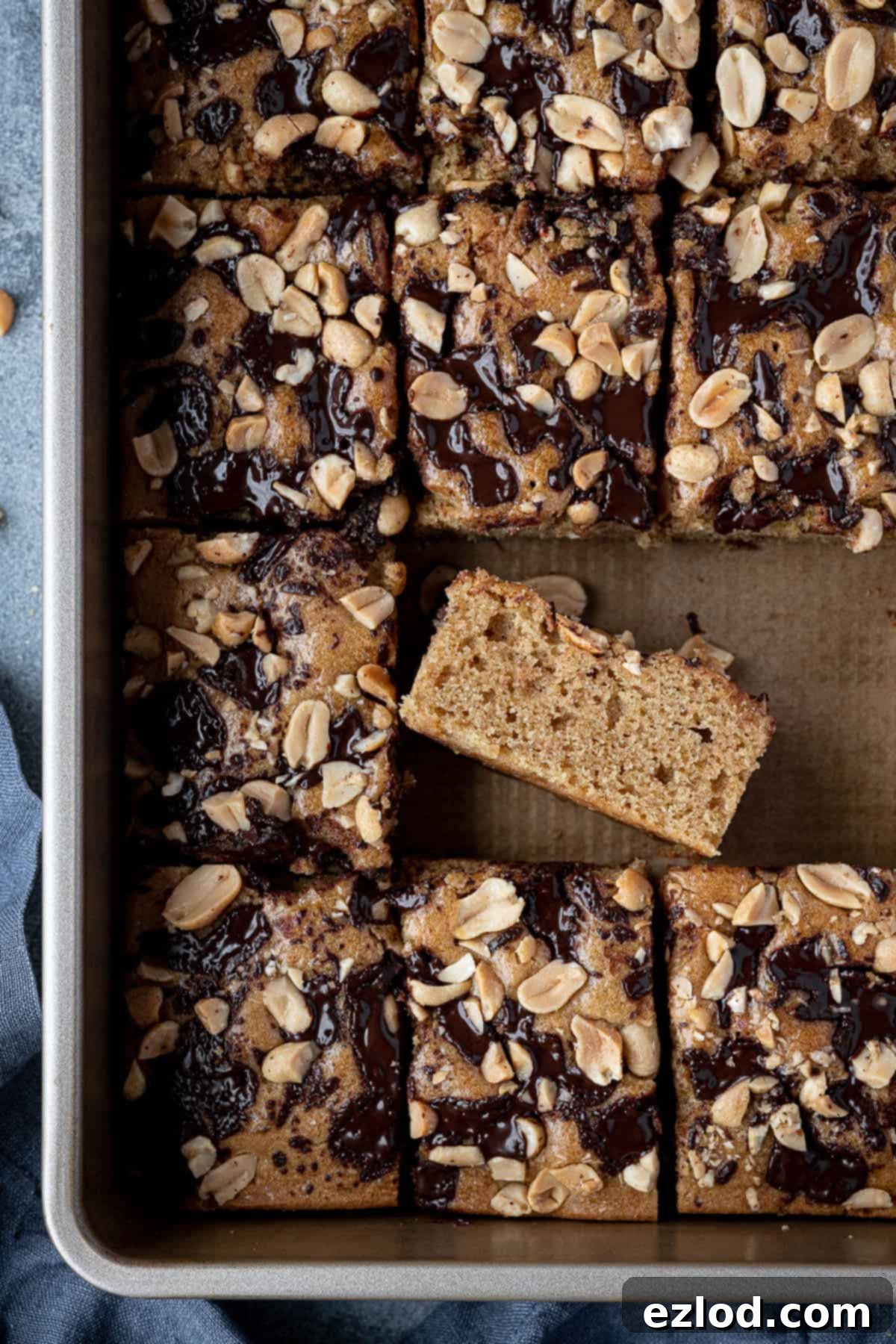
This vegan peanut butter cake is a true masterpiece of simplicity and flavor. Designed as a versatile traybake, it’s perfect for casual snacking at home, but also elegant and indulgent enough to take center stage at any party, potluck, or birthday celebration. Its inviting aroma alone is enough to draw a crowd!
At its heart lies a melt-in-the-mouth tender vegan peanut butter sponge, crafted to be exquisitely moist and light. This delightful base is generously adorned with finely chopped dark chocolate (or your favorite vegan chocolate chips) and a scattering of perfectly roasted peanuts. The contrast is simply divine: the soft, yielding cake against the satisfying crunch of the peanuts creates a textural symphony that will have everyone coming back for another slice. It’s a guaranteed crowd-pleaser, delivering rich, satisfying flavors without any dairy or animal products.
This recipe is a vegan adaptation of a brilliant creation from One Tin Bakes Easy by the incredibly talented Edd Kimber, ensuring a tried-and-tested foundation for a truly exceptional plant-based dessert. We’ve fine-tuned it to perfection, making it incredibly accessible for home bakers of all skill levels.
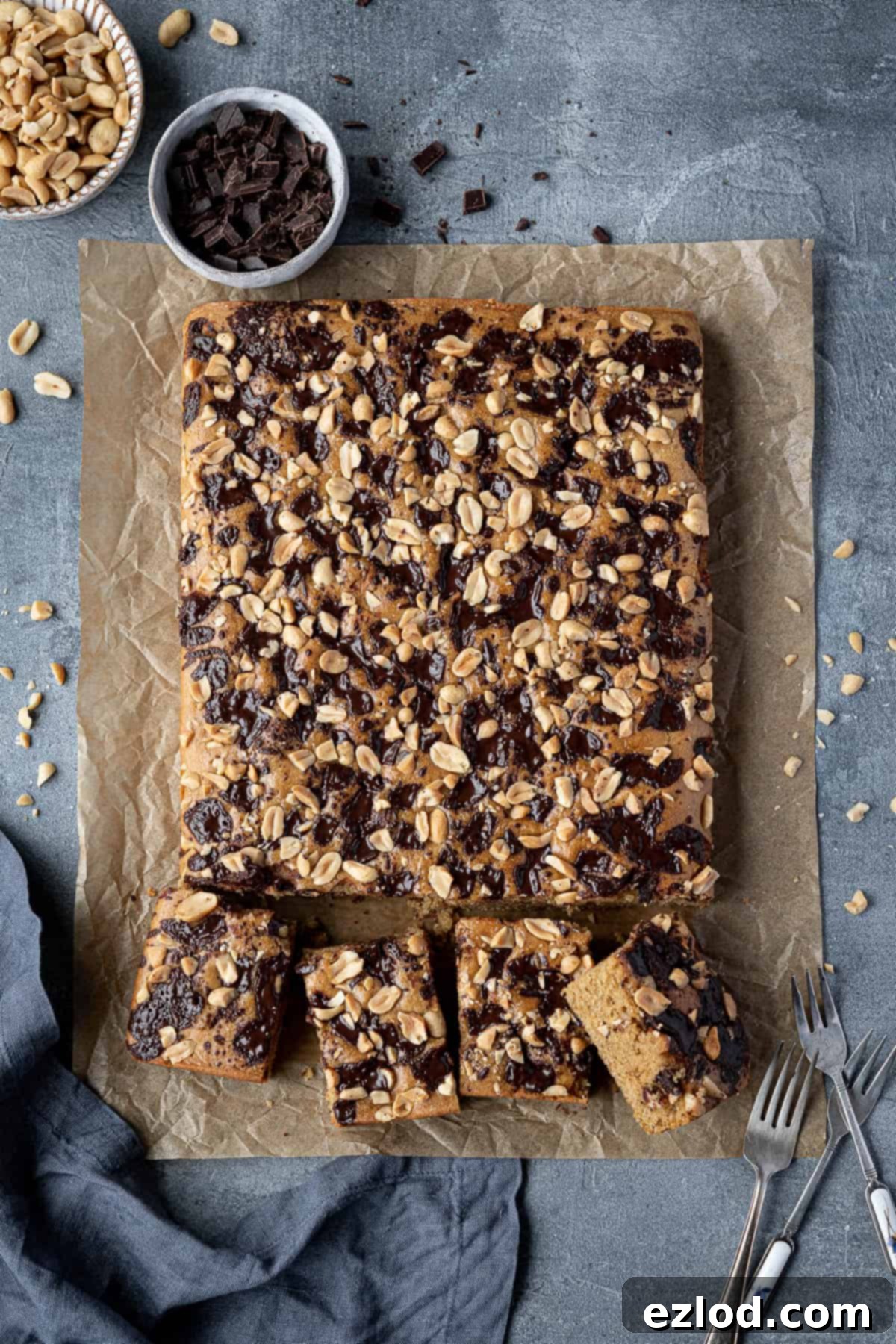
Why You’ll Love This Easy Vegan Peanut Butter Cake
There are countless reasons to fall in love with this recipe. First and foremost, it’s incredibly easy to make, requiring minimal fuss and basic kitchen equipment. You don’t need any fancy techniques or hard-to-find ingredients to achieve spectacular results. Secondly, the texture is simply divine – a perfectly moist and fluffy crumb that melts in your mouth, enhanced by the delightful chewiness of chocolate and the satisfying crunch of peanuts. It’s a harmonious blend of flavors and textures that satisfies every craving.
As a plant-based dessert, it’s suitable for vegans and those with dairy allergies, making it an inclusive treat for any gathering. Yet, its incredible taste means everyone, regardless of dietary preference, will enjoy it. The combination of sweet and salty notes from the peanut butter and roasted peanuts, balanced with the rich chocolate, creates a deeply satisfying flavor profile that keeps you wanting just one more piece. It’s also highly versatile, equally at home as a comforting snack with a cup of tea or as an impressive dessert for a special occasion.
Essential Ingredients for Your Vegan Peanut Butter Cake:
Crafting the perfect vegan peanut butter cake starts with understanding the role of each ingredient. Here’s a detailed look at what you’ll need and why:

Peanut Butter: The Heart of the Flavor
For this recipe, a smooth, creamy peanut butter is highly recommended over natural varieties. Natural peanut butter tends to be drier and can separate, affecting the cake’s texture and consistency. A smooth, processed peanut butter (like Whole Earth smooth, as the original recipe suggests) integrates seamlessly into the batter, ensuring a moist and even crumb with that distinct, comforting peanut flavor. Opt for a brand you love for the best taste!
Neutral Flavored Oil: For Moisture and Tenderness
A neutral-flavored oil, such as sunflower or a mild olive oil, is crucial here. It contributes to the cake’s moistness and tender crumb without imparting any strong flavors that might compete with the peanut butter. Coconut oil is generally not recommended unless you have no other option, as its distinct flavor and solid state at room temperature can alter the final taste and texture of the cake. Always choose a liquid oil that won’t overpower the delicate balance of flavors.
Unsweetened Plant-Based Milk: The Liquid Base
Any variety of unsweetened non-dairy milk will work, but soy milk is often preferred due to its higher protein content. This protein can contribute to a slightly richer and more stable crumb structure, similar to how dairy milk functions in traditional baking. Ensure it’s unsweetened to control the sugar levels in the cake and prevent it from becoming overly sweet. Almond, oat, or cashew milk can also be used successfully, just be mindful of their subtle flavor profiles.
Light Brown Soft Sugar: For Depth and Moisture
Light brown soft sugar is chosen for its ability to add not just sweetness, but also extra moisture and a subtle caramel-like depth of flavor to the cake. Its finer crystals dissolve easily, contributing to a smooth batter. While caster sugar, granulated sugar, or even coconut sugar can be used as alternatives, be aware that these may result in a slightly different moisture content and flavor profile. Brown sugar truly enhances the richness of the peanut butter.
Vinegar: The Leavening Activator
A small amount of vinegar plays a vital role in this vegan cake. It reacts with the bicarbonate of soda (baking soda) to create carbon dioxide gas, which helps the cake rise and achieve its light, fluffy texture. This acid-base reaction is essential for a good lift. White vinegar or apple cider vinegar are both suitable options; their flavor is neutralized during baking, leaving no discernible taste.
Vanilla Extract: The Flavor Enhancer
Vanilla extract is far superior to vanilla essence, offering a richer, more authentic vanilla flavor that complements the peanut butter beautifully. You can also use vanilla bean paste for an even more intense and visually appealing flecked appearance. Don’t skip this ingredient, as vanilla adds a layer of warmth and complexity that elevates the entire cake.
Plain Flour: The Structural Foundation
Just regular plain (all-purpose) flour is needed for this recipe. It provides the necessary structure without being too heavy. Swapping it for wholemeal flour is generally not recommended, as the higher bran content can make the cake too dense and alter its delicate texture. Sifting the flour before use helps to aerate it and prevent lumps, contributing to a smoother batter.
Baking Powder and Bicarbonate of Soda: The Dynamic Duo for Rise
Using a combination of both baking powder and bicarbonate of soda (baking soda) ensures the best possible rise and a wonderfully light, soft texture. Baking powder is a complete leavening agent, while bicarbonate of soda requires an acid (like the vinegar in this recipe) to activate. Together, they create a perfect lift, preventing the cake from becoming flat or heavy.
Dark Chocolate: The Perfect Partner
You have flexibility here – use either chopped dark chocolate or chocolate chips. Ensure your chocolate is vegan-friendly if maintaining a strict plant-based diet. Dark chocolate provides a lovely bittersweet contrast to the sweet and nutty cake, creating a classic flavor pairing. If you prefer a milder chocolate flavor, vegan milk chocolate chips can also be used.
Roasted Peanuts: For Crunch and Salty Balance
Roasted peanuts, especially salted ones, are the ideal topping. The saltiness of the peanuts beautifully complements the sweetness of the cake and the richness of the dark chocolate, creating an addictive sweet and savory profile. Their crunch also offers a fantastic textural counterpoint to the soft cake, making every bite exciting. Chop them roughly to ensure they are well distributed.
How To Make Vegan Peanut Butter Cake:
(Full measurements and detailed instructions can be found in the recipe card at the bottom of the page)
Making this vegan peanut butter cake is a straightforward process, designed for ease and enjoyment. Here’s how you’ll bring it to life:
Begin by combining the creamy peanut butter and neutral oil in a large mixing bowl. Whisk them together until the mixture is completely smooth and homogenous. This initial step ensures a well-emulsified base for your cake batter, preventing any oil separation and contributing to an even texture throughout the cake.
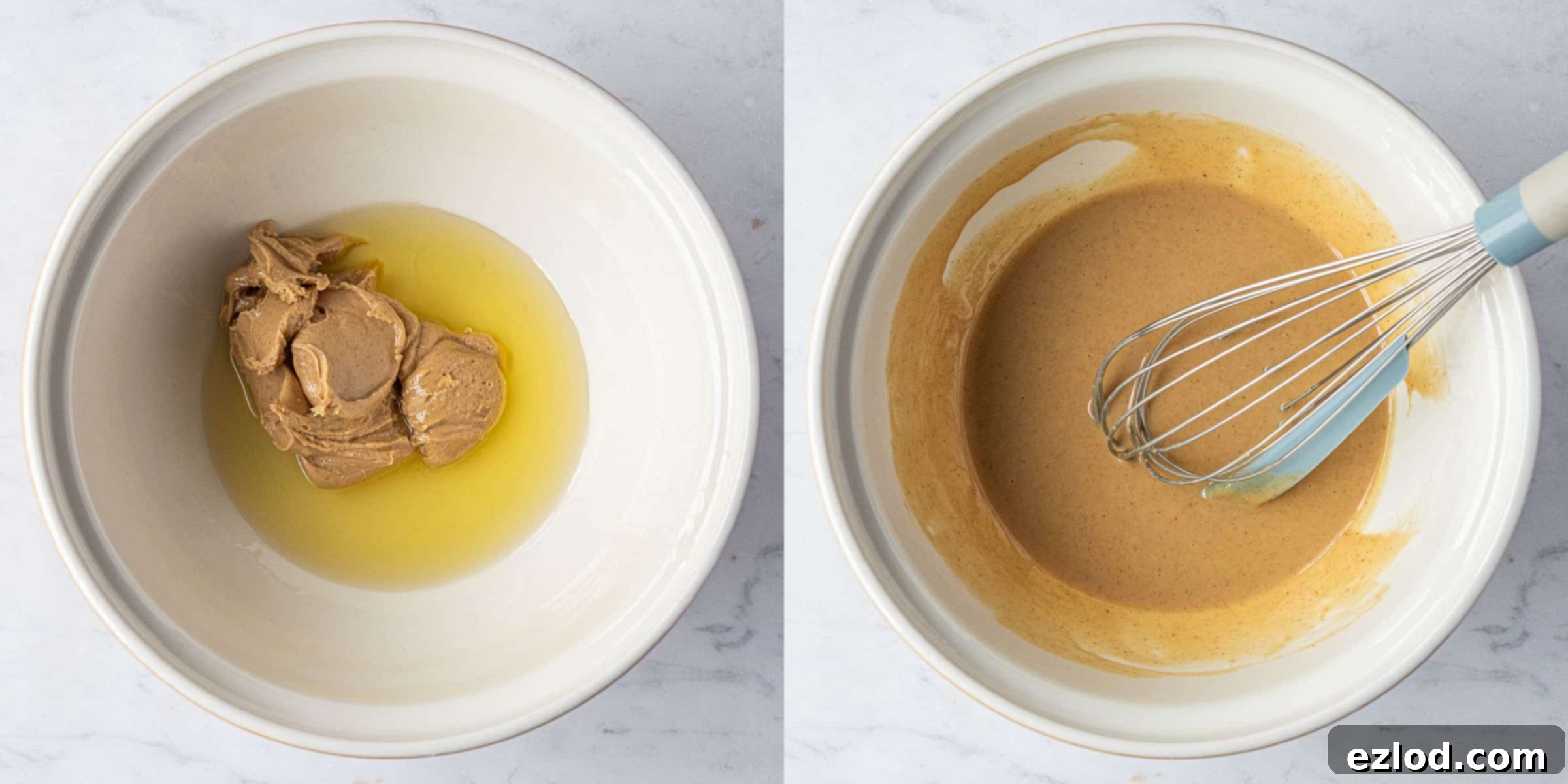
Next, add the light brown soft sugar to the peanut butter and oil mixture. Continue to whisk thoroughly until the sugar is fully incorporated and the mixture appears light and fluffy. This step helps to aerate the wet ingredients, contributing to the cake’s tender crumb. Ensure there are no visible sugar granules before proceeding.
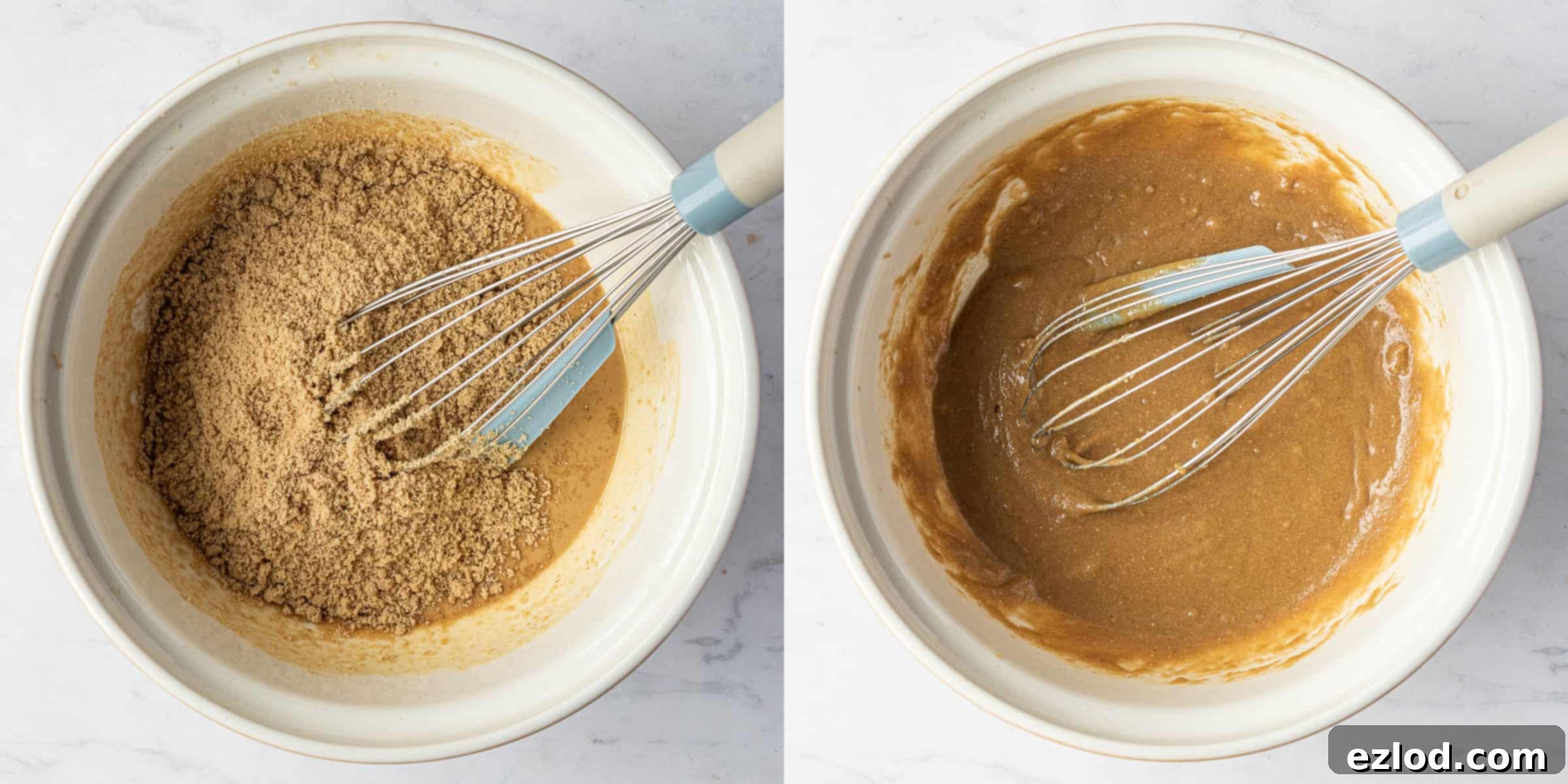
Now, whisk in the unsweetened plant-based milk, vanilla extract, vinegar, and salt. Mix until everything is well combined and the liquid ingredients are fully integrated. In a separate bowl, sift together the plain flour, baking powder, and bicarbonate of soda. Sifting is crucial as it removes any lumps and ensures the dry ingredients are evenly distributed, leading to a consistent rise.
Add the sifted dry ingredients to your wet mixture. Using a balloon whisk, gently stir until just combined and no dry lumps remain. It’s important not to overmix at this stage; over-beating can develop the gluten in the flour too much, resulting in a tough cake. Mix only until the flour streaks disappear, keeping the batter light and airy.
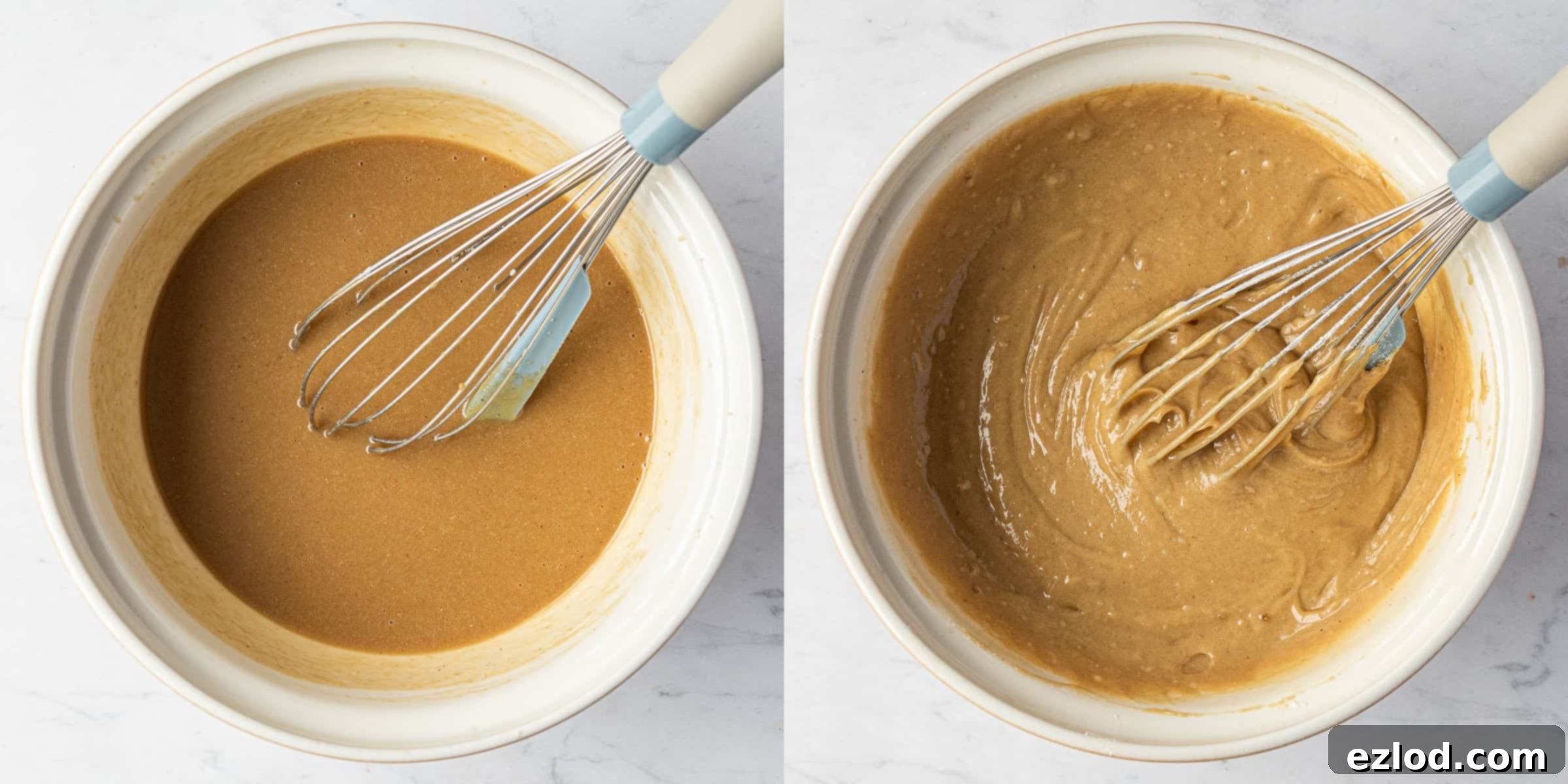
Pour the prepared batter into your greased and lined 23 x 33 cm (9 x 13 inch) tin. Use a spatula to spread the batter evenly across the tin, ensuring a uniform thickness for consistent baking. Finally, generously scatter the chopped dark chocolate and roasted peanuts over the entire surface of the batter. This ensures every slice will have a delightful combination of flavors and textures.
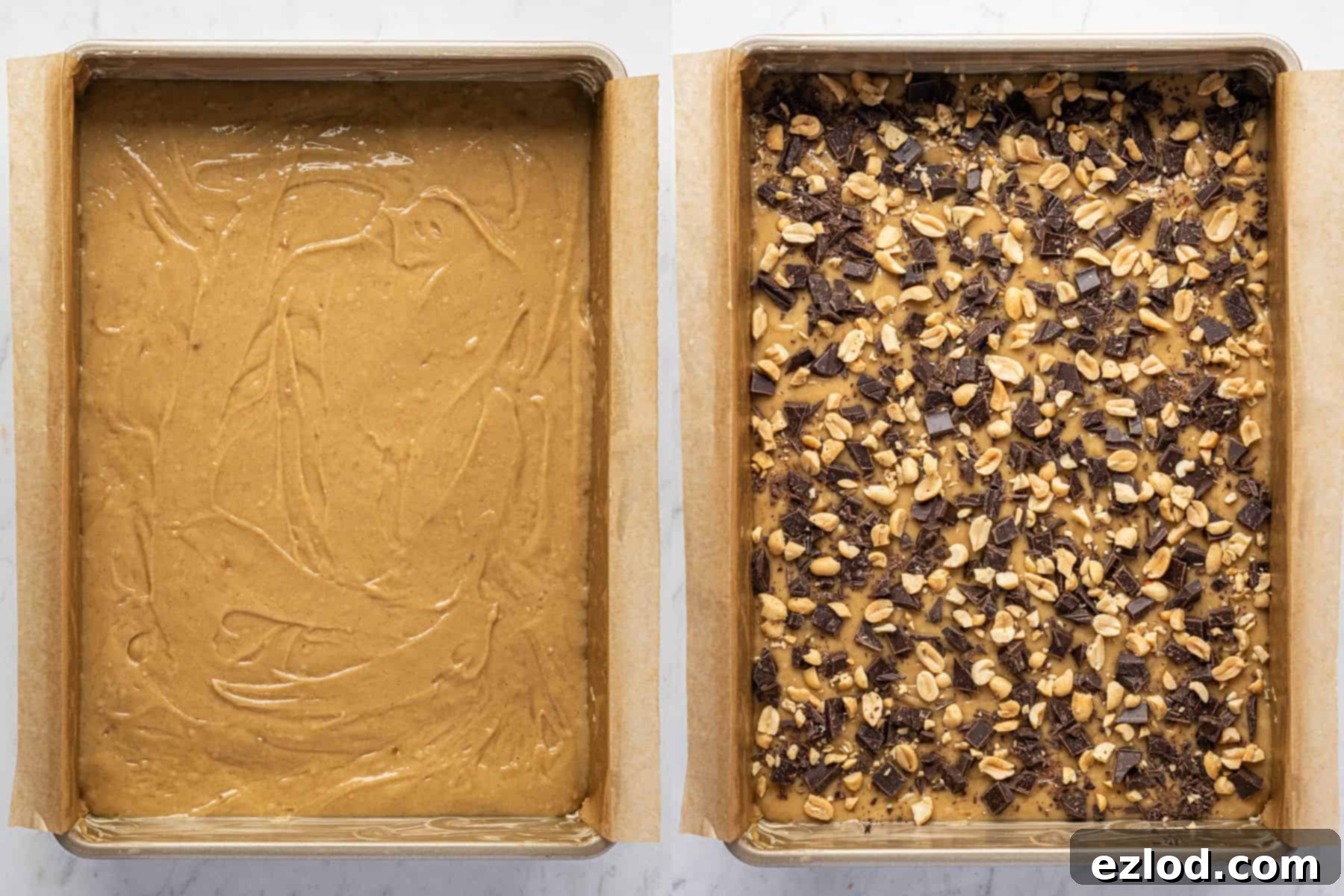
Bake the cake for 20-25 minutes in your preheated oven. You’ll know it’s ready when the top is firm to the touch and a skewer inserted into the center comes out clean. Avoid opening the oven door too frequently during baking to maintain a consistent temperature. Once baked, let it cool slightly in the tin before carefully removing it.
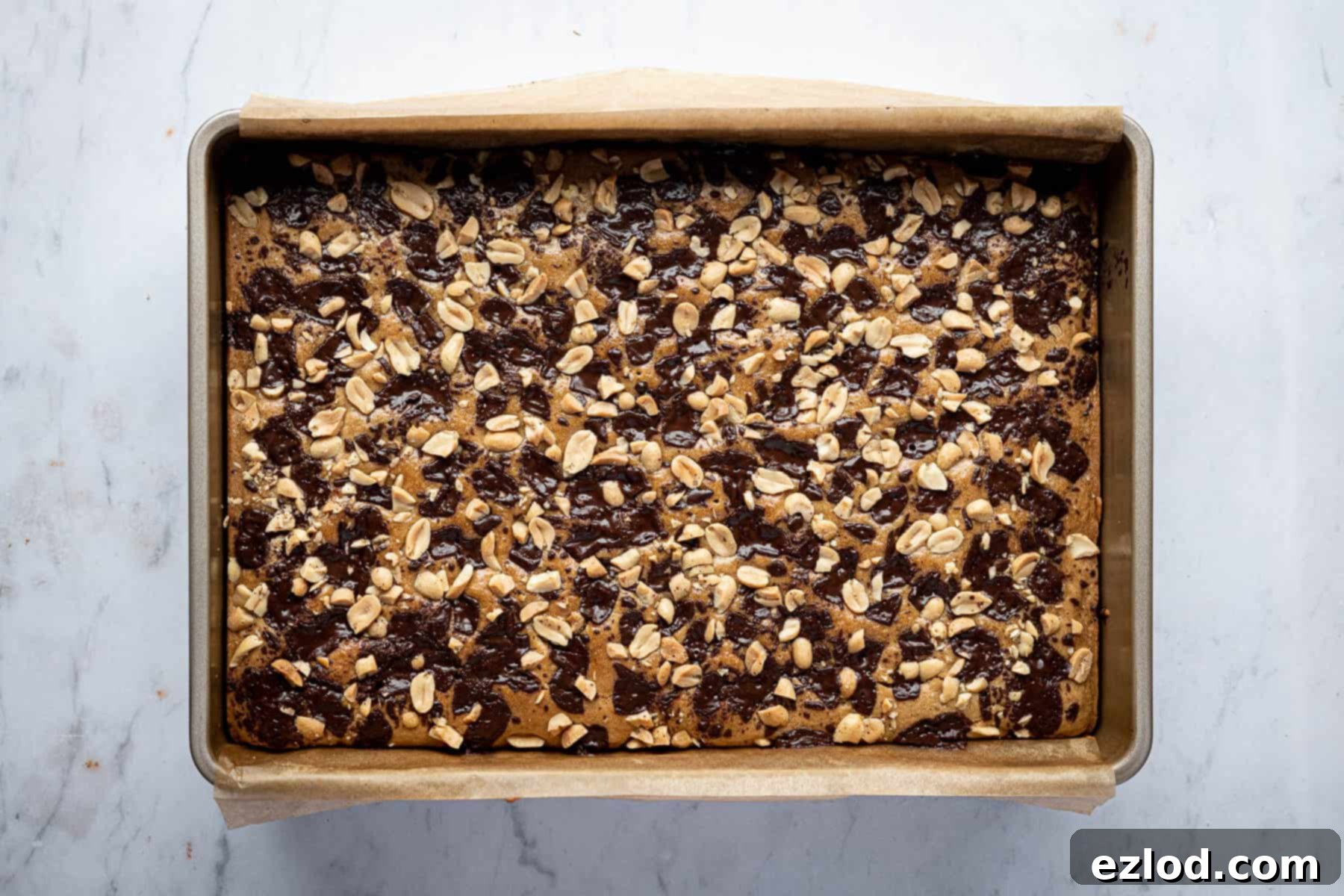
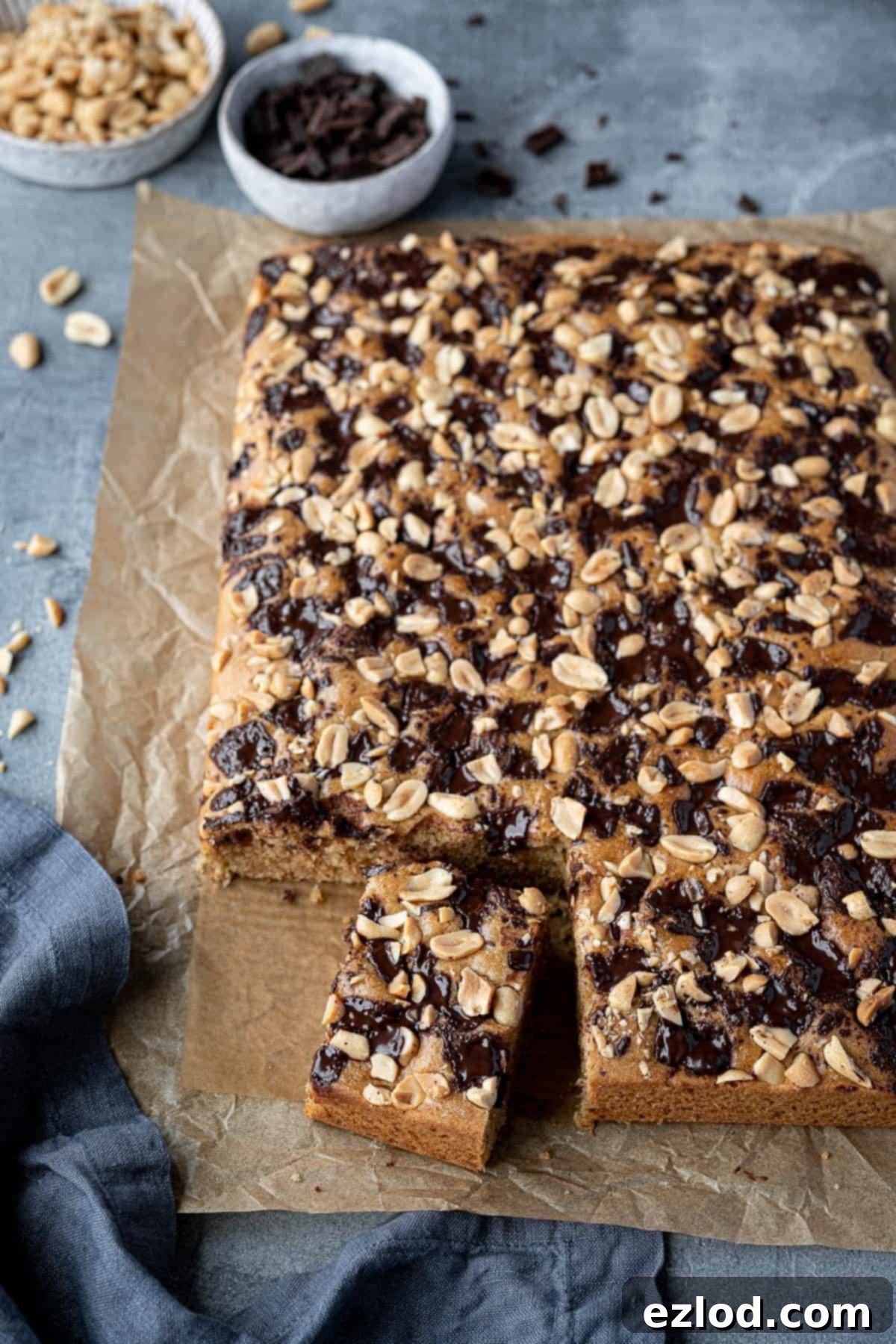
Expert Baking Tips for the Best Vegan Peanut Butter Cake
To ensure your vegan peanut butter cake turns out perfectly every time, keep these expert tips in mind:
Precision in Measurement: Weighing vs. Cups
All successful baking relies on precision, and this recipe is no exception. My recipes are developed using grams, and I strongly advocate for using metric measurements with a digital scale rather than cup conversions. Cups are notoriously inaccurate, leading to inconsistent results, especially in baking where ingredient ratios are critical. A digital scale ensures exact quantities, resulting in a more reliable and delicious outcome every time. Plus, it’s often cleaner and quicker than scooping and leveling cups!
Avoiding Over-Mixing for a Tender Crumb
One of the most crucial tips for a light and tender cake is to avoid over-beating the batter once the dry ingredients are added. Over-mixing develops the gluten in the flour, leading to a tough, chewy cake rather than a soft and delicate one. Mix only until no dry lumps remain, and no more. I highly recommend stirring by hand with a balloon whisk for better control, allowing you to stop just as the last streaks of flour disappear.
To further prevent over-mixing, ensure your wet ingredients and dry ingredients are extremely well mixed in their separate bowls *before* you combine the two. This way, less mixing is required once they come together.
Customizing Your Cake: Versatile Variations
While this recipe is designed for a sheet pan, it’s incredibly adaptable. You can bake this cake in two 20cm (8-inch) round cake tins instead, transforming it into a layer cake. If doing so, consider filling and topping it with a decadent vegan peanut butter buttercream frosting instead of the chocolate and peanuts for an even more indulgent dessert. You could also experiment with other toppings like a drizzle of caramel sauce, chopped pretzels for extra crunch and saltiness, or different nuts like cashews or almonds.
Storage for Maximum Freshness
Proper storage is key to enjoying your delicious cake for longer. This vegan peanut butter cake will remain fresh and moist for up to 4 days when stored in an airtight container at room temperature. Keeping it sealed prevents it from drying out and helps preserve its wonderful texture and flavor. Avoid refrigerating, as this can sometimes dry out cakes.
Freezing Instructions: Plan Ahead!
Yes, this vegan peanut butter cake freezes exceptionally well, whether you want to freeze it whole or in individual slices. To freeze, ensure the cake is completely cool first. Wrap it tightly in several layers of plastic wrap, then an additional layer of aluminum foil to prevent freezer burn. It can be frozen for up to three months. When you’re ready to enjoy it, simply allow it to defrost at room temperature for a few hours before serving. This makes it a fantastic make-ahead option!
Serving Suggestions
This versatile vegan peanut butter sheet cake can be enjoyed in many ways. Serve it as a delightful afternoon treat with your favorite cup of coffee or tea. For a more decadent dessert, warm a slice slightly and pair it with a scoop of vegan vanilla ice cream or a dollop of coconut whipped cream. A fresh fruit compote, especially berries, can provide a lovely tangy contrast to the richness of the cake. It’s also perfect for packed lunches, picnics, or simply as a comforting end to any meal.
Frequently Asked Questions (FAQ)
Can I make this cake gluten-free?
While this recipe hasn’t been specifically tested with gluten-free flour, you might be able to achieve good results using a good quality 1:1 gluten-free baking blend that contains xanthan gum. However, the texture may vary slightly, often being a bit denser or crumblier. It’s always best to follow the original recipe first for the intended texture.
What if I don’t have vinegar?
The vinegar is crucial for activating the baking soda. If you don’t have vinegar, lemon juice can be used as a direct substitute. The acidity will provide the necessary reaction to help the cake rise properly. Do not omit the acid entirely, as this will significantly impact the cake’s texture and rise.
Can I reduce the sugar in this recipe?
While it might be tempting to reduce the sugar for dietary reasons, sugar plays a vital role in the cake’s structure, moisture, and browning, not just sweetness. Significantly reducing the sugar can lead to a drier, tougher cake that doesn’t brown as well. For best results, it’s recommended to stick to the specified amount.
More Delicious Vegan Sheet Cake Recipes
If you’ve enjoyed this easy and delicious vegan peanut butter cake, you’ll love exploring these other plant-based sheet cake recipes, perfect for any occasion:
- Vegan chocolate hazelnut cake
- Vegan jam and coconut sponge
- Vegan pumpkin spice latte cake
- Easy ginger cake
- Vegan chocolate sheet cake
- Raspberry, chocolate and almond sheet cake
- Vegan coffee and walnut cake
- Vegan cherry almond cake
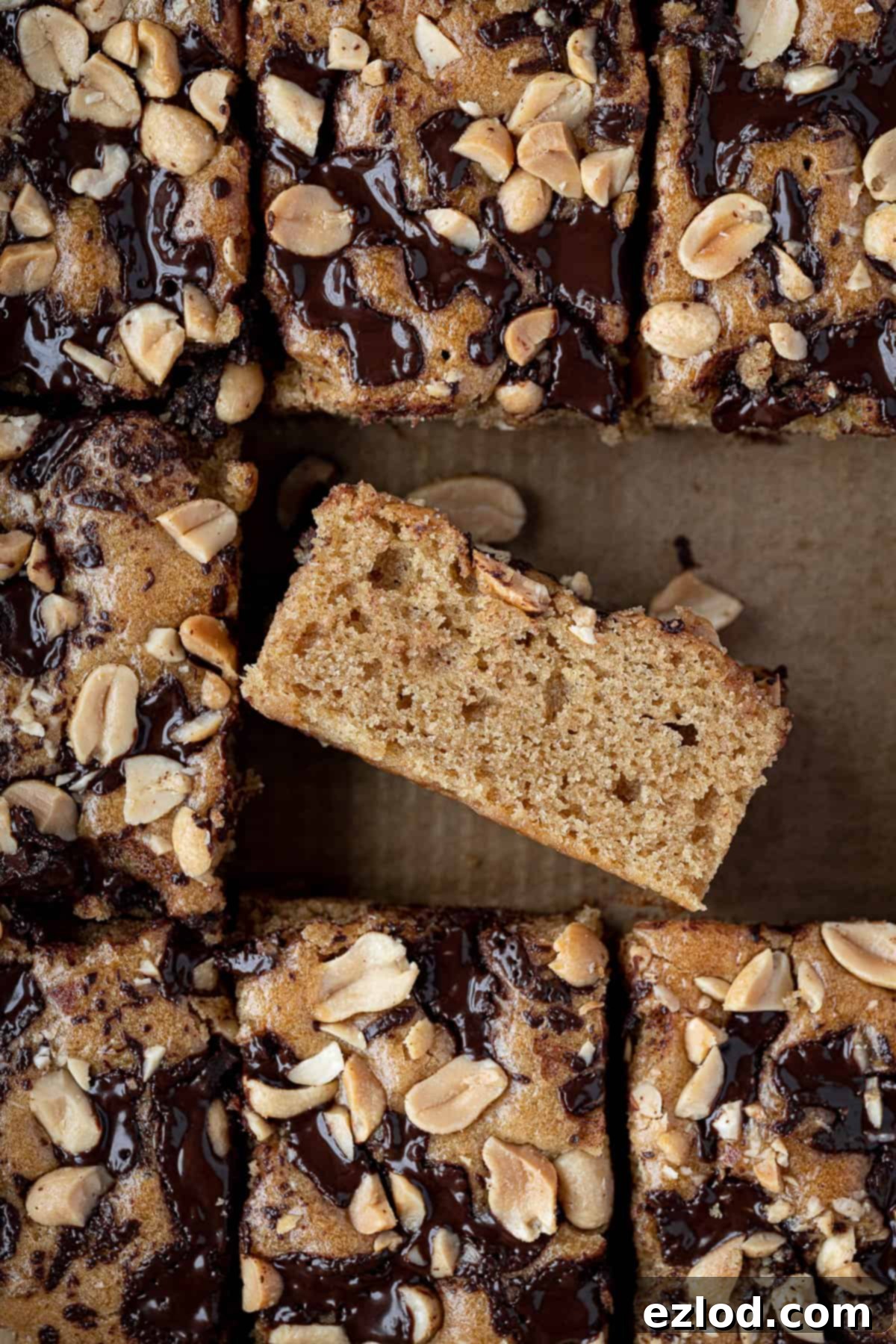
If you tried this recipe let me know how it went! Rate it, leave a comment or tag @domestic_gothess on Instagram and hashtag it #domesticgothess
All images and content on Domestic Gothess are copyright protected. If you want to share this recipe then please do so by using the share buttons provided. Do not screenshot or post the recipe or content in full, instead include a link to this post for the recipe.

Print
Vegan Peanut Butter Cake
Ingredients
- 100 g (3 ½ oz) dark chocolate or chocolate chips
- 60 g (2 oz) roasted peanuts
- 150 g (⅔ cup) smooth creamy peanut butter
- 80 ml (⅓ cup) neutral oil (such as sunflower)
- 220 g (1 ¼ cups) light brown soft sugar
- 240 ml (1 cup) unsweetened non-dairy milk (I use soy)
- 2 teaspoons vanilla extract
- 1 teaspoon vinegar
- ¼ teaspoon salt
- 280 g (2 ¼ cups) plain (all-purpose) flour
- 1 teaspoon baking powder
- 1 teaspoon bicarbonate of soda (baking soda)
Instructions
-
Preheat the oven to 180°C/160°C fan/350°F/gas mark 4. Grease a 23 x 33cm/9 x 13 in rectangular cake tin and line with baking parchment, leaving some overhanging so that you can easily lift the cake out of the tin.
-
Roughly chop the chocolate (unless you are using chocolate chips) and the peanuts. Set aside.
-
Whisk together the peanut butter and oil until smooth. Whisk in the sugar until fully combined. Whisk in the milk, vanilla, vinegar and salt.
-
Sift together the plain flour, baking powder and bicarbonate of soda.
-
Add the dry ingredients to the wet and stir with a balloon whisk until no dry lumps remain.
-
Pour the batter into the prepared tin and spread it level. Scatter the chopped chocolate and peanuts over the top.
-
Bake for 20-25 minutes until firm to the touch and a skewer inserted into the centre comes out clean.
-
Leave the cake to cool in the tin for 20 minutes then carefully use the overhanging parchment to lift it out onto a wire rack (don’t try and remove the parchment, the cake is very delicate).
Notes
- See post above for tips, details and step-by-step photos.
- All of my recipes are developed using grams, and as with all of my baking recipes I really do recommend using the metric measurements with a digital scale rather than the cup coversions. Cups are a wildly inaccurate measuring system and you will get far better, more consistent results using a scale, not to mention that it is also easier and less messy than cups!
